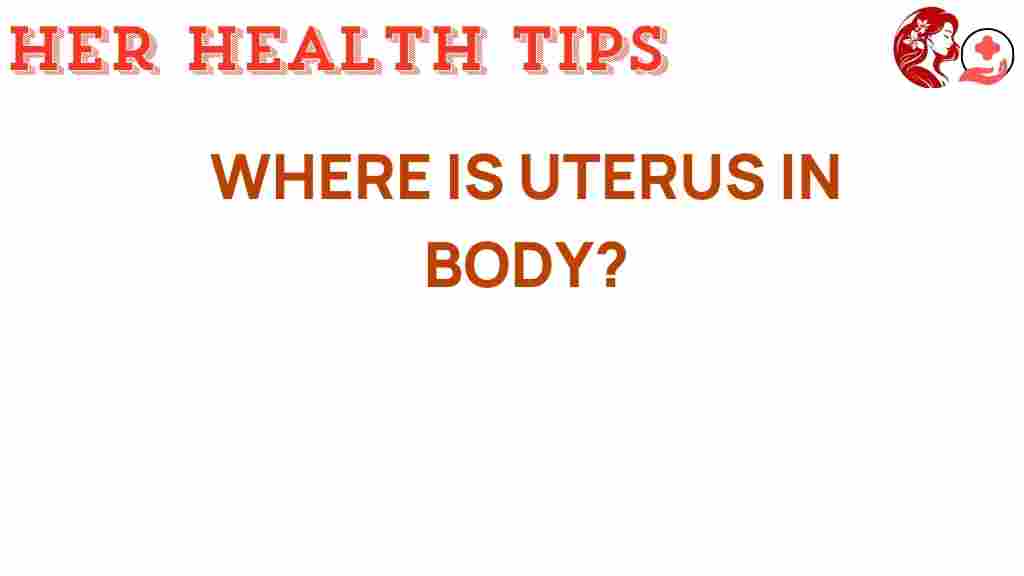Unraveling the Mystery: Where is the Uterus Located in the Body?
The uterus, a vital organ in the female reproductive system, plays a crucial role in women’s health and biology. Understanding its anatomy and location is essential for both educational purposes and overall health awareness. In this article, we will explore the anatomy of the uterus, its location within the body, and its significance in the female reproductive system.
Understanding the Uterus: Anatomy and Function
The uterus, also known as the womb, is a hollow, muscular organ located in the pelvis. Its primary function is to house and nourish a fertilized egg during pregnancy. The anatomy of the uterus consists of several key components:
- Fundus: The upper, rounded part of the uterus.
- Body: The main part of the uterus where a fertilized egg implants.
- Cervix: The narrow, lower portion of the uterus that opens into the vagina.
- Endometrium: The inner lining of the uterus that thickens during the menstrual cycle.
- Myometrium: The muscular layer that contracts during childbirth.
Each of these components plays a significant role in the reproductive process. The uterus is primarily responsible for the implantation of the embryo, the growth and development of the fetus during pregnancy, and the shedding of its lining during menstruation.
Location of the Uterus in the Body
To understand the location of the uterus, it’s essential to consider the anatomy of the pelvis and surrounding organs. The uterus is situated in the pelvic cavity, which is bordered by the pelvic bones and contains various pelvic organs. Here’s a breakdown of its location:
- The uterus is located between the bladder and the rectum.
- It rests on the pelvic floor, supported by ligaments and connective tissue.
- The cervix projects into the upper part of the vagina.
The average position of the uterus is typically tilted forward, a position known as anteverted. However, some women may have a retroverted uterus, where the uterus tilts backward. This variation in position is normal and does not usually impact health or fertility.
Significance of the Uterus in Women’s Health
The uterus is not just a reproductive organ; it also plays a significant role in a woman’s overall health. Conditions affecting the uterus can lead to various health issues, including:
- Menstrual Disorders: Irregularities can indicate underlying health issues.
- Fibroids: Non-cancerous growths that can cause pain and heavy bleeding.
- Endometriosis: A condition where tissue similar to the endometrium grows outside the uterus.
- Uterine Prolapse: A condition where the uterus descends into the vaginal canal due to weakened pelvic support.
Awareness of these conditions is essential for women’s health education and proactive health management.
Step-by-Step Process: Understanding Uterine Health
Maintaining uterine health is vital for overall well-being. Here’s a step-by-step guide to understanding and managing uterine health:
- Regular Check-ups: Schedule gynecological exams to monitor uterine health.
- Know Your Cycle: Track menstrual cycles to identify any irregularities.
- Stay Informed: Educate yourself about common uterine conditions.
- Healthy Lifestyle: Maintain a balanced diet and regular exercise to promote overall health.
- Seek Help: Consult a healthcare provider if you experience symptoms like severe pain or heavy bleeding.
By following these steps, women can take charge of their health and ensure that their uterus, a central part of the female reproductive system, remains healthy.
Troubleshooting Common Uterine Health Issues
Understanding potential issues related to the uterus can help in early detection and treatment. Here are some common conditions and troubleshooting tips:
- Heavy Menstrual Bleeding: If you experience heavy bleeding, consider keeping a menstrual diary to track patterns and discuss this with your doctor.
- Pelvic Pain: Persistent pelvic pain should not be ignored. It can signify conditions such as fibroids or endometriosis.
- Irregular Cycles: If your menstrual cycle varies significantly, it may be beneficial to consult a healthcare provider for evaluation.
- Fertility Issues: Inability to conceive after one year of unprotected intercourse warrants a visit to a fertility specialist.
It’s essential for women to listen to their bodies and seek medical advice when necessary. Early intervention can lead to better outcomes and preserve reproductive health.
Education and Resources for Women’s Health
Education is crucial for understanding health issues related to the uterus and the female reproductive system. Numerous resources are available for women to learn more about uterine health:
- Women’s Health Organizations provide valuable information on uterine health and related conditions.
- Books and online courses focused on women’s health topics can enhance understanding of anatomy and physiology.
- Healthcare providers can be excellent resources for information tailored to individual health needs.
Staying educated ensures that women can make informed decisions regarding their health and well-being.
Conclusion
In conclusion, understanding the uterus’s location and anatomy is vital for women’s health and education. The uterus plays a crucial role in the female reproductive system, impacting not only reproduction but overall well-being. By maintaining awareness of its health and addressing any issues promptly, women can ensure that they lead healthy lives. Regular check-ups, education, and a proactive approach to health are essential in unraveling the mystery of where the uterus is located in the body and what it means for women’s health.
For further reading on women’s health, visit this resource for comprehensive information.
This article is in the category Reproductive and created by HerHealthTips Team

1 thought on “Unraveling the Mystery: Where is the Uterus Located in the Body?”